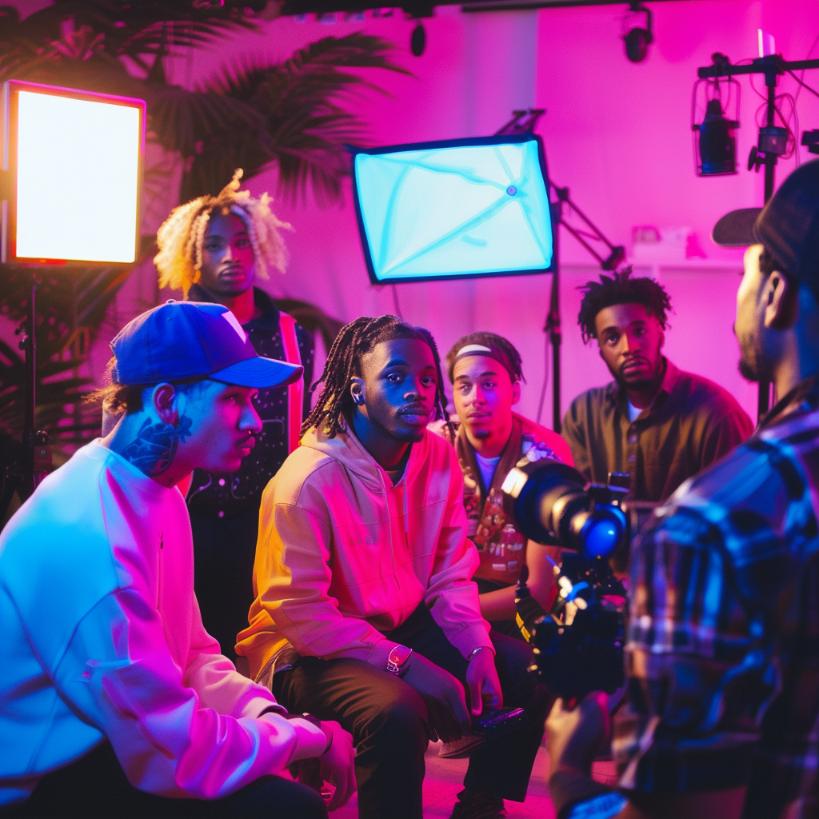YouTube Collaborations: Unlocking New Audiences and Creative Potentials
Introduction to YouTube Collaborations
YouTube collaborations involve two or more creators coming together to produce content that is shared across their respective channels. This partnership can take various forms and is often used as a strategic method to leverage each creator’s audience, bringing fresh perspectives and increased exposure to all parties involved.
Forms of YouTube Collaborations:
Guest Appearances: One of the simplest forms of collaboration involves featuring as a guest on another creator’s video. This can be a Q&A session, a reaction video, or participating in challenges, where the guest brings their unique flair to the host’s channel.
Co-Producing Content: Creators may come together to co-produce content, sharing responsibilities for scripting, filming, and editing. This often results in a video series that is posted across all collaborators’ channels, each featuring different aspects or episodes of the series.
Cross-Promotions: In this form, creators promote each other’s content on their respective channels. This might not involve direct content creation but can include shout-outs, video recommendations, or sharing each other’s content on community tabs and social media.
Joint Ventures: More complex collaborations can lead to joint ventures where creators launch a new channel together or embark on a larger project that combines their skills and resources. This can range from educational series to entertainment projects.
Virtual Collaborations: With the rise of digital tools, creators don’t even need to be in the same physical location to collaborate. They can create split-screen videos, compilations, or even compete in challenges remotely.
These collaborative efforts not only help in reaching wider audiences but also in creating content that might be too resource-intensive for one creator to handle alone. By pooling resources, creators can achieve higher production values and introduce their viewers to new content styles and formats.
Benefits of Collaborations
YouTube collaborations offer a multitude of benefits that can significantly enhance a creator’s channel from multiple angles. These partnerships are not only about reaching a larger audience but also about enriching the content and learning from peers.
Extending Reach and Audience Introduction:
Collaborating with other creators allows you to tap into their audiences, introducing your channel to viewers who might not have discovered it otherwise. This cross-pollination of audiences can lead to rapid increases in subscriber counts and views. For instance, if a viewer enjoys a collaboration video, they are likely to visit the other creator’s channel and potentially subscribe if they find the content appealing.
Increasing Subscriber Counts:
The natural progression from increased exposure is an increase in subscriber counts. When your content resonates with the new audience brought in by your collaborator, these viewers are more likely to subscribe to your channel. This is particularly effective because the endorsement from a creator they already trust (your collaborator) acts as a strong validation of your content.
Skill Exchange and Creative Growth:
Collaborations also serve as a platform for skill exchange. Working with other creators can help you learn new techniques and creative processes. This exchange of knowledge can lead to significant improvements in the quality of your content. Whether it’s a new editing style, a different approach to scripting, or innovative content ideas, these new skills can refresh your content and make your channel more dynamic.
Enhanced Creative Output:
The synergy of different creative minds can lead to content that is more engaging, innovative, and appealing. Collaborations often push creators out of their comfort zones, inspiring them to experiment with new content types and presentation styles. This not only keeps the existing audience engaged but also attracts new viewers looking for unique and fresh content.

Finding the Right Collaboration Partners
Choosing the right partners for YouTube collaborations is crucial to ensuring the success of the joint venture. The compatibility between collaborating channels significantly influences the effectiveness of the collaboration in terms of audience reception and overall content quality.
Tips on Identifying Potential Collaborators:
Align Content Style and Audience Demographics:
- Look for creators whose content style complements or resonates with your own. This alignment ensures that their audience is likely to appreciate your content as well.
- Analyze potential collaborators’ audience demographics to ensure there’s an overlap with your own audience. This overlap means that viewers from both channels are more likely to engage with the collaborative content.
Assess Content Quality and Consistency:
- Evaluate the quality of potential partners’ content. High production values, consistent posting schedules, and strong viewer engagement are good indicators of a dedicated and professional creator.
- Consistency in content theme and quality ensures that the collaboration will meet the expectations of both audiences.
Research Their Reputation and Past Collaborations:
- Look into their past collaborations to see how well they worked with others and how successful those projects were. This can give you insights into their collaborative spirit and the potential success of your joint effort.
- Check reviews or feedback from their community to gauge their reputation within the YouTube ecosystem.
The Importance of Shared Values and Goals:
Shared Values:
- Ensure that your values and those of your potential collaborators align. This alignment is critical in avoiding conflicts that could arise from differing opinions on content boundaries or ethical considerations.
- Shared values foster a collaborative environment where all parties feel respected and valued, which is essential for a productive creative process.
Common Goals:
- Discuss your goals for the collaboration early in the planning stages to ensure everyone is on the same page. Whether it’s increasing subscriber count, breaking into a new demographic, or simply experimenting with new content types, having common goals sets a clear direction for the collaboration.
- When all collaborators are working towards the same objectives, the project is more likely to succeed and yield the desired outcomes.
Finding the right collaboration partner involves careful consideration of content compatibility, audience alignment, and shared values and goals. By meticulously selecting collaborators who complement your creative vision and professional standards, you can enhance the chances of your collaborative projects achieving significant success and mutual benefit.
Planning and Executing a Collaboration
Effective planning and execution are key to the success of any YouTube collaboration. From conceptualizing the project to finalizing the logistics, every step needs careful consideration to ensure that the collaboration benefits all parties involved and runs smoothly.
Steps for Planning a Collaborative Project:
Concept Development:
- Brainstorm Together: Initiate a brainstorming session with your collaborator to generate ideas that play to both of your strengths. This collaborative ideation ensures the concept resonates well with both audiences.
- Select a Theme: Choose a theme or topic that is timely, relevant, and interesting to both your audiences. Make sure it offers enough depth to warrant a collaboration, providing new insights or entertainment value that wouldn’t be as strong with just one creator.
Role Allocation:
- Define Roles Clearly: Assign roles based on each creator’s skills and preferences. For example, one might handle the scripting and on-camera hosting, while the other takes care of editing and post-production.
- Balance Responsibilities: Ensure that responsibilities are evenly distributed to prevent any imbalances that could strain the collaboration. Clear communication about who is doing what minimizes confusion and maximizes efficiency.
Logistical Arrangements:
- Schedule Coordination: Agree on a timeline for the project, including shooting and editing schedules, and set deadlines for each phase of the project. Use tools like shared calendars or project management apps to keep everyone aligned.
- Technical Setup: Determine the technical requirements for the project, including equipment, filming locations, and any special needs for the content. If remote collaboration is necessary, test all equipment and software in advance to avoid technical glitches.
Guidance on Managing the Collaboration Process:
Maintain Open Communication: Regular check-ins throughout the project can help address any issues as they arise and ensure that all collaborators remain on track. Use video calls, chats, or emails to keep the lines of communication open.
Flexibility and Adaptability: Be prepared to adapt plans as needed. Flexibility can be crucial when dealing with unforeseen challenges such as scheduling conflicts or creative differences.
Fair Credit and Promotion: Agree in advance on how credit will be given and how the final product will be promoted on each channel. This agreement should respect the contributions of all parties and ensure mutual promotion to maximize the reach of the collaboration.
Feedback and Revisions: Once a draft of the collaborative project is ready, review it together and be open to feedback. This collaborative review process ensures the final content meets the high standards expected by both creators and their audiences.
By following these structured steps and maintaining a cooperative and respectful partnership throughout the planning and execution phases, YouTube collaborations can be both creatively rewarding and beneficial in terms of audience engagement and growth.
Promoting Collaborative Content
Once a YouTube collaboration is complete, effective promotion is essential to maximize its reach and impact. Cross-promoting collaborative videos on both channels and leveraging additional platforms can significantly enhance visibility and engagement.
Strategies for Cross-Promoting Collaborative Videos:
Simultaneous Release: Plan to release the collaborative content simultaneously on both channels. This approach helps capture the audience from both sides at the peak of their interest and encourages cross-visitation between channels.
Shared Teasers and Previews: Before the release, share teasers or previews on each channel. This builds anticipation among your respective audiences and provides a sneak peek of what’s to come, encouraging viewers to watch the full collaboration.
Featured Channels and Video Shout-outs: Utilize the “featured channels” section on your YouTube channel to promote your collaborator’s channel, and vice versa. Additionally, mention the collaboration in other videos leading up to and following the release to keep it top of mind for your audience.
Custom Thumbnails and Titles: Create visually cohesive thumbnails and complementary titles for the videos on each channel. This visual and textual alignment helps reinforce the connection between the two pieces of content and enhances recognition across audiences.
Leveraging Social Media and Community Engagement:
Coordinated Social Media Campaigns: Use all available social media platforms to promote the collaboration. Schedule posts to go live at strategic times across your and your collaborator’s platforms. Utilize engaging formats like stories, posts, and live sessions to discuss the collaboration and direct traffic to both channels.
Interactive Elements: Include interactive elements such as Q&As, live premieres, or post-release discussions where both creators participate. These activities can increase direct engagement, making the collaborative content more compelling and shareable.
Hashtags and Social Media Tags: Create unique hashtags for the collaboration and encourage your followers to use them when discussing the content. Tag each other in your posts to improve visibility to each other’s followers and facilitate easy sharing of the content.
Engage with Comments and Feedback: Actively engage with viewers’ comments on both YouTube and social media platforms. Responding to comments, especially in the first few hours after release, can significantly boost the video’s engagement metrics and encourage further sharing.
Follow-up Content: Consider creating follow-up content that references the collaboration. This can keep the conversation going and maintain interest in both channels. Follow-up content might include behind-the-scenes videos, bloopers, or discussions about the collaboration process and experiences.
By implementing these promotion strategies, you can effectively amplify the reach of your collaborative projects, attract new viewers, and strengthen your community engagement, all of which contribute to the long-term success of your YouTube channel.
Navigating Challenges
Collaborating on YouTube can bring substantial rewards, but it also comes with its share of challenges. From creative differences to scheduling conflicts and varied audience receptions, effectively navigating these obstacles is crucial for maintaining a productive partnership and ensuring the success of the collaboration.
Common Challenges and Solutions:
Creative Differences:
- Open Communication: Foster an environment where all parties feel comfortable expressing their ideas and concerns. Regular and open communication can prevent misunderstandings and ensure that all voices are heard.
- Compromise and Flexibility: Be willing to compromise and find middle ground that satisfies all collaborators. Remember, the goal is to blend the best ideas from all parties to create something unique that resonates with a wider audience.
- Clear Roles and Boundaries: Establish clear roles and boundaries from the start. Knowing who has the final say in certain aspects of the project can help manage expectations and streamline decision-making.
Scheduling Conflicts:
- Advanced Planning: Use tools like shared calendars to schedule key dates well in advance. This can help avoid last-minute conflicts and ensure that all collaborators are on the same page.
- Regular Updates: Keep each other updated about any changes in availability. Regular updates can help adjust the timeline as needed without major disruptions.
- Flexible Deadlines: Where possible, build some flexibility into your project timeline to accommodate unexpected delays or conflicts.
Audience Reception:
- Target Audience Research: Before launching the collaboration, conduct thorough research to understand the combined audience demographics and preferences. This can guide the content direction and reduce the risk of negative reception.
- Transparent Communication: Let your audiences know why you chose to collaborate and how it benefits them. Transparency can help manage expectations and foster acceptance.
- Feedback Loop: After releasing the collaborative content, monitor audience feedback closely. Be proactive in addressing any concerns and willing to learn from the feedback for future projects.
Best Practices for Resolving Issues Amicably:
- Conflict Resolution Plan: Develop a conflict resolution plan at the beginning of the collaboration. Agree on how you will handle disagreements or issues that arise during the project.
- Neutral Mediation: If conflicts escalate, consider bringing in a neutral third party to mediate. Sometimes, an external perspective can help clarify issues and broker peace.
- Post-Project Reviews: After completing the project, conduct a review session to discuss what went well and what could be improved. This reflection can strengthen the relationship and improve the workflow for future collaborations.
Navigating the challenges of YouTube collaborations with patience, understanding, and strategic planning can enhance the creative process and lead to successful outcomes. By anticipating potential issues and having strategies in place to address them, creators can ensure that collaborations are not only productive but also enjoyable experiences.

Measuring Success and Building Relationships
Successful YouTube collaborations aren’t just about producing content together; they also involve measuring the impact of that content and nurturing ongoing relationships with collaborators. Proper evaluation and relationship management can pave the way for future projects and continued mutual growth.
Measuring the Success of a Collaboration:
Engagement Metrics:
- View Count and Watch Time: These are basic indicators of how much interest the collaboration has generated. High view counts and extended watch times suggest that the content was appealing to the audience.
- Likes, Comments, and Shares: Engagement metrics like likes, comments, and shares provide deeper insights into how the audience interacted with the video. High engagement rates typically indicate that the content resonated well with viewers.
- Subscriber Growth: Monitor any spikes in subscriber numbers following the collaboration. An increase suggests that new viewers valued the content enough to want more from the channel.
- Cross-Channel Traffic: Look at how much traffic was driven to each collaborator’s channel from the collaboration. This helps assess the reciprocity of audience sharing between channels.
Audience Feedback:
- Direct Comments: Viewer comments can offer qualitative insights into how the collaboration was received. Positive feedback, constructive criticism, and viewer suggestions can all guide future content.
- Surveys and Polls: For more structured feedback, consider using surveys or polls. These tools can gather specific information about what the audience liked and what they didn’t, providing a clearer picture of the collaboration’s impact.
Building and Maintaining Relationships:
- Regular Communication: Keep in touch with collaborators after the project. Regular check-ins can maintain the rapport and open doors for future collaborations.
- Express Gratitude: Always thank your collaborators for their efforts. A simple message of appreciation can go a long way in maintaining a positive relationship.
- Share Opportunities: If you come across opportunities that might benefit a past collaborator, share them. This generosity helps strengthen professional bonds and fosters a supportive network.
- Collaborative Growth: Celebrate each other’s successes and support each other’s growth. Engage with and promote your collaborator’s new content, showing that the partnership extends beyond a single project.
Future Collaborations:
- Feedback and Iteration: Use the insights gained from measuring the success of the collaboration to refine approaches for future projects. Discuss what worked and what could be improved with your collaborators.
- Planning Next Steps: If the collaboration was successful, discuss the possibility of further projects. Planning future content together can capitalize on the momentum and success of your initial efforts.
Measuring success and maintaining good relationships are crucial for creators looking to build sustainable and beneficial partnerships. By focusing on both quantitative results and qualitative feedback, creators can not only gauge the success of their collaborations but also lay the groundwork for future projects that continue to engage and grow their audiences.

